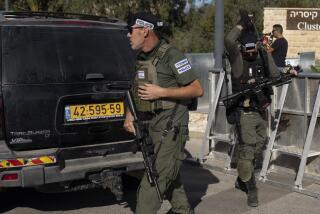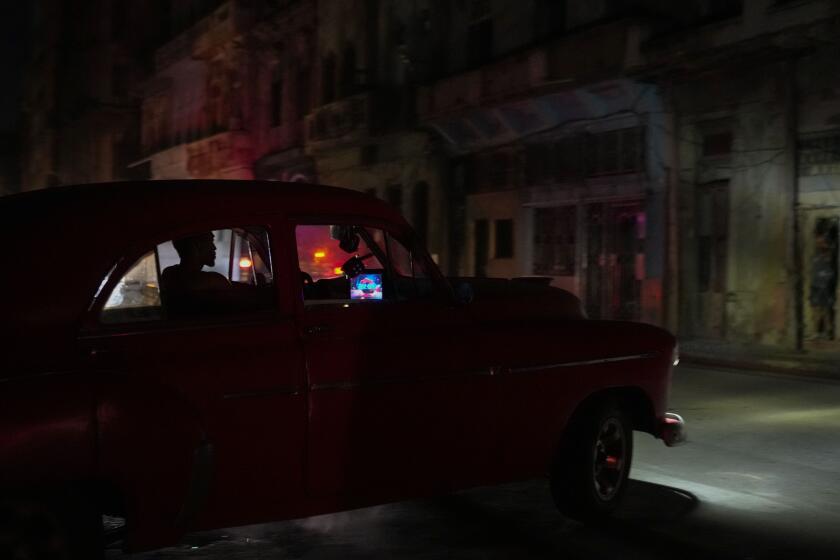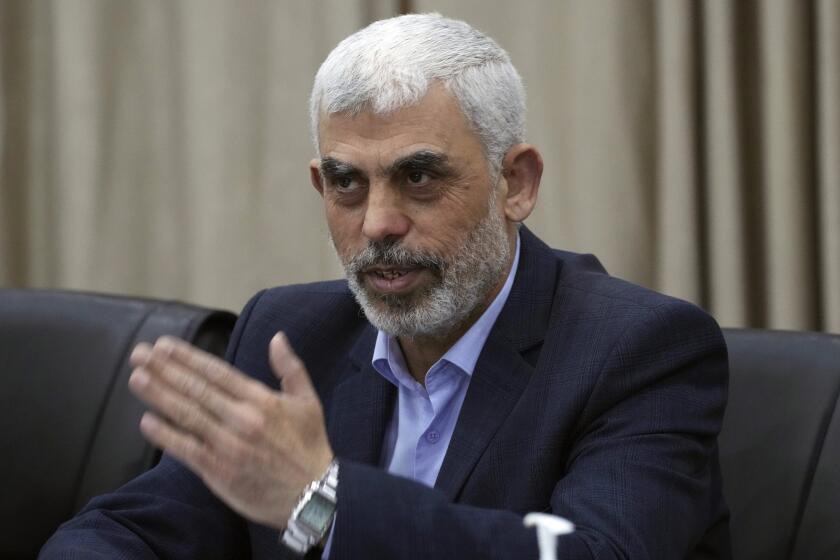NATO Blasts Rebel Serb Targets Near Sarajevo : Bosnia: Air strike comes in retaliation for defiant weapons raid. Allied attack destroys a ‘tank-buster’ gun.
NATO warplanes attacked Bosnian Serb military positions near Sarajevo on Friday after the rebels crowned a desperate round of provocations by seizing weapons from U.N. peacekeepers and forcing down a French helicopter with machine-gun fire.
Sixteen North Atlantic Treaty Organization planes, including four U.S. A-10s, scrambled from alliance air bases across Italy for a sundown sweep over the Serbian-encircled Bosnian capital, blasting at preset targets and destroying at least one 76-millimeter “tank-buster” gun.
The first use of Western air power near Sarajevo spurred an immediate bleat of contrition from one rebel leader, who apologized for the pre-dawn raid on the weapons depot and promised to give back the captured hardware, said Michael Williams from U.N. Protection Force headquarters in Zagreb, Croatia.
But Williams, the senior spokesman for the beleaguered peacekeeping mission, voiced skepticism that the rebel military leaders have been so quickly cowed.
“There remains a question in our minds that the reassurances this evening are from the Bosnian Serb political leaders, and one would hope those reassurances would also apply to the military leaders,” Williams said, adding that the mission has learned “all too often (the Bosnian Serbs) fall back into a pattern of provocations and difficulties.”
Assurances that the stolen T-55 tank, two armored personnel carriers and an antiaircraft gun would be returned were offered by Momcilo Krajisnik, the self-styled parliamentary leader who often strikes a moderate pose while the Bosnian Serb military presses on with offensives.
There were reports that some of the equipment had been returned. But British Lt. Gen. Michael Rose, the U.N. commander in Bosnia-Herzegovina, gave the Serbs until today to surrender all the weapons taken from Ukrainian troops guarding a containment site in Serbian-held Ilidza.
Rose warned that he is ready to renew his call for air strikes if the Bosnian Serbs persist in violating a weapons exclusion zone proclaimed around Sarajevo in February and backed by NATO threats to bomb heavy weapons menacing the city.
U.N. mission commanders moved swiftly to avoid the kind of retaliation inflicted by Bosnian Serbs after two token NATO air strikes in April against rebel artillery attacking the U.N. “safe area” of Gorazde.
All air activities in and around Sarajevo were suspended, including a food airlift on hold since July 20. U.N. troops in Bosnian Serbian-held areas were earlier redeployed out of the rebels’ reach.
“We learned some lessons from the April experience,” Williams conceded, alluding to instances of hostage-taking and harassment of U.N. forces after the earlier air strikes.
At NATO’s Southern European Command in Naples, Italy, U.S. Adm. Leighton Smith said a desire to avoid civilian casualties was the determining factor in selecting the air strike targets.
U.N. and NATO military leaders ordered the pilots to strike only if they could be certain of “zero collateral damage,” Smith said, using the military euphemism for civilian fatalities.
Forward air controllers reported at least one sighting of ground-to-air retaliatory fire during the NATO attack, a senior Pentagon official in Washington said. But no damage or injuries were sustained, and all aircraft returned safely to their Italian bases, Smith said.
The antitank weapon destroyed in the air strike was nine miles southwest of central Sarajevo, “well within the 20-kilometer exclusion zone,” Smith told reporters, referring to the 12.5-mile radius delineated around the Bosnian capital in February.
The attack force consisted of four French Mirage F-1 CTs, four British Jaguar fighters, four Dutch F-16s and the U.S. A-10s; there was also a handful of support aircraft.
Only two A-10 “Warthogs” actually fired at the Bosnian Serb positions, said Capt. Rich Eich, a spokesman at the Naples headquarters.
No bombs were dropped, but the two aircraft fired about 600 rounds between them from their 30-millimeter guns, Eich said.
At least the one M-18 antitank gun was destroyed, and NATO and U.N. forces were still assessing the results of the action, he said.
The White House and State Department welcomed the NATO action, which was called for by Rose, who has previously shown reluctance to use force against the Bosnian Serb belligerents for fear of exposing his peacekeeping troops to retaliation.
Secretary of State Warren Christopher called the NATO attack a way of keeping additional pressure on the Bosnian Serbs to accept an international peace plan for Bosnia. “I think it was a good step forward today,” he said.
Rose insisted that the attack in no way compromised the neutrality of his forces, saying the air strikes were “a proportionate response.”
But by repeatedly stressing at a briefing in Sarajevo after the bombing that his mission is “not going to war with the Serbs,” Rose may have encouraged the rebel leadership to continue probing the limits of Western resolve to force an end to the worst bloodshed in Europe since World War II.
At NATO headquarters in Brussels, the sense of relief was almost tangible that the U.N. mission had actually called for alliance air strikes.
Tension between the two organizations has been more or less constant since NATO issued its first ultimatum Feb. 9 that led to an end of 22 months of artillery bombardment of Sarajevo.
The alliance, eager to preserve its credibility as a potent military force, has often been frustrated by the United Nations’ reluctance to act.
But in the more than two years of fighting in Bosnia, the Bosnian Serbs have never been more isolated diplomatically. Abandoned--at least for the moment--by their only allies of any significance in Moscow and Belgrade, diplomatic pressure against air strikes was virtually zero.
Forces loyal to Bosnian Serb leader Radovan Karadzic provoked the NATO attack with a series of aggressive moves against Sarajevo and U.N. forces over the past weeks punctuating their refusal to accept a U.S.- and European-mediated peace plan.
The last straw appeared to be the barrage of small-arms fire that forced down a French Puma helicopter that was trying to track the four heavy-artillery pieces stolen from the U.N. containment site around 4 a.m.
Rose appealed to the U.N. Protection Force commander, French Gen. Bertrand de Lapresle, for air power to punish the blatant violation of NATO’s edict against heavy artillery being deployed within the exclusion zone.
Most Bosnian Serb tanks, guns and howitzers had been withdrawn to avoid air strikes ahead of the February NATO deadline. But recent reluctance to punish violations with force had encouraged the rebels to gradually reposition dozens of guns and mortars around Sarajevo.
U.N. peacekeeping officials had been treading lightly in the face of Bosnian Serb violations, probably in the expectation that they would accept a negotiated settlement of the conflict.
Instead, Karadzic and the ultranationalists who dominate his rogue government rejected the take-it-or-leave-it peace plan and moved to close in on Sarajevo by cutting off its sole supply route, grounding a humanitarian airlift and dramatically stepping up sniper and mortar fire against civilians.
Bosnian Serb fighters had put the peacekeeping mission on notice earlier this week that they intended to retrieve weapons surrendered to the United Nations in February, claiming that they were needed for battles raging elsewhere in Bosnia.
That prompted Rose to warn he would use any means available to him to prevent the weapons’ recapture, including air strikes.
But the U.N. hierarchy’s earlier reluctance to use force against the rebels, coupled with a timid response by the mediating countries at a meeting in Geneva last weekend, probably led the Bosnian Serbs to believe the latest threats were also empty.
Diplomats from the United States, Russia, Britain, France and Germany have drafted a settlement proposal that aims to bring peace to Bosnia by dividing it, granting the Bosnian Serb rebels rule over 49% and a Muslim-Croatian federation the rest.
The Muslim-backed Sarajevo government reluctantly approved the plan, but the Serbs have repeatedly rejected it, demanding control over all conquered territory and the right to annex it to the neighboring state of Serbia.
The Retaliation
To protect Sarajevo, NATO imposed a weapons exclusion zone around the city on Feb. 21. NATO had been reluctant to use air strikes. But the seizure of weapons by Bosnian Serbs threatened an increasingly shaky truce.
THE PROVOCATION
1) An undetermined number of Bosnian Serbs raid U.N. weapons depot, seizing a tank, armored personnel carriers and other weapons.
2) U.N. commanders send a French Puma helicopter to track the tank, but the helicopter is forced down by several rounds of small-arms fire.
THE RESPONSE
3) U.S. A-10 jets blast apart a “tank-buster” gun in one of four NATO responses. The Pentagon would not reveal the three other targets.
NATO Involvement
The North Atlantic Treaty Organization’s air strikes against Bosnian Serb targets in Bosnia-Herzegovina on Friday marked the fourth time that the Western alliance has used force in the civil war. Every attack has been on Bosnian Serb targets. Following is a chronology of NATO’s growing involvement in Bosnia:
* July, 1992: NATO agrees to use naval force in Adriatic to review compliance with U.N. sanctions imposed on Serbia and Montenegro, which make up the rump Yugoslavia.
* October, 1992: NATO agrees to use surveillance aircraft to monitor U.N. ban on military flights over Bosnia.
* April, 1993: NATO begins combat patrols with fighters over Bosnia to enforce compliance with U.N. ban on flights.
* June, 1993: NATO offers close air support to U.N. troops and other personnel in Bosnia if they are attacked and request air strikes.
* August, 1993: NATO threatens air strikes against Bosnian Serb forces attacking Sarajevo.
* January, 1994: NATO summit meeting in Brussels confirms all previous decisions and says it is ready to use air strikes to help reopen Tuzla’s airport for aid flights if necessary.
* February, 1994: NATO gives Bosnian Serbs 10 days to withdraw heavy weapons from around Sarajevo or hand them over to U.N. control; otherwise, they will face air strikes. The Serbs comply.
* U.S. fighters, part of the NATO force, shoot down four Bosnian Serb jets that violate the U.N. ban on flights over Bosnia. It is NATO’s first combat action since it was founded in 1949 to counter Soviet military power in Europe.
* April, 1994: NATO launches two air strikes against Bosnian Serb forces around Gorazde to protect U.N. personnel, the first allied attacks on ground targets.
* April 22, 1994: NATO says it will use air strikes to protect all six U.N.-designated “safe areas” in Bosnia and gives the Bosnian Serbs a deadline to withdraw from Gorazde. They comply and there are no strikes.
* Aug. 5, 1994: NATO planes hit Bosnian Serb heavy weapons that are violating the exclusion zone around Sarajevo after the rebel Serbs remove arms from a U.N. weapons depot.
Source: Reuters
More to Read
Sign up for Essential California
The most important California stories and recommendations in your inbox every morning.
You may occasionally receive promotional content from the Los Angeles Times.










